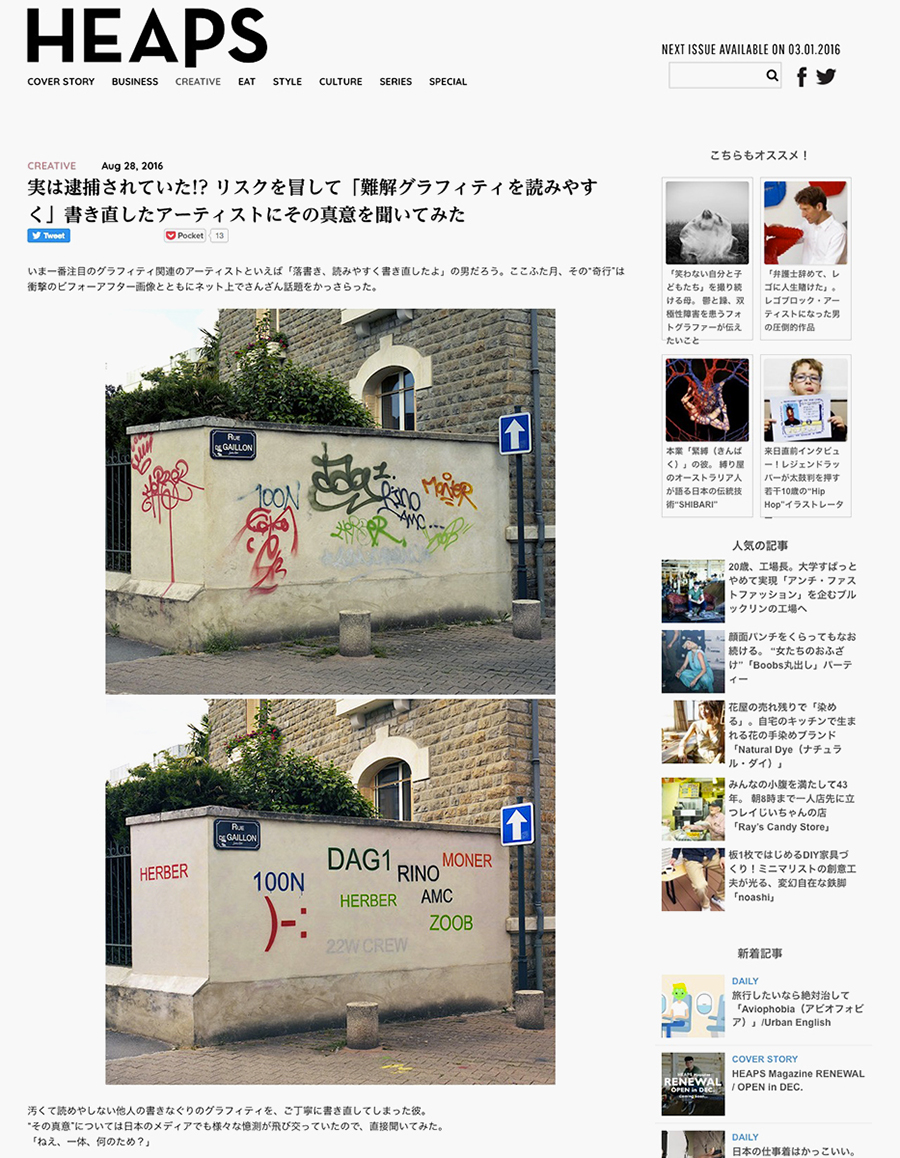[Mathieu Tremblin, French Artist Who Paints Over Illegible Graffiti to Legible], Yu Takamichi, Heaps Magazine, www.heapsmag.com, 28th August 2016.
[EN]
Yu Takamichi: Tags in the city is basically hard to read. Wasn’t is for you?
Mathieu Tremblin: It wasn’t because I’m a former tagger. So basically this Tag Clouds intervention is giving to profanes the opportunity to look at the graffiti in the same way graffiti writers experience it when they are walking around the city. They read at the same time and with the same facility graffiti names on the walls or corporate brands on the signs. That’s the main reason the idea of this intervention came to my mind; a hall of fame looks like a tag cloud and those clouds are linking the wall to each other as if tags were hyperlinks, drawing then a new drifting path in the city.
YT: If it was, how did you read?
MT: When I had some difficulty to recognize the name, I walked around the city to find other tags done with the same colored spray or marker. Or I tried to find similar global looking signatures in order to decipher ones that where better written. Or I asked local writers if they knew about the name of the author of the tags I couldn’t decipher.
YT: Were there tags you gave up to read? If there were, please tell me how were they like?
MT: No, but I made a mistake on a 1&2 which I transcripted 182; some writers I didn’t knew about at the time. As far as I know, I didn’t make any other mistakes because I had confirmation of the local graffiti scene each time.
YT: Any interesting tags?
MT: There is plenty of taggers who are skilled in handstyling over the world.
From a French perpsective, you can have a look at AZYLE, O’CLOCK, UV TPK crew, PAL crew who are among my favorites for the different styles of tagging they represent.
YT: I guess there’re tons of tags in France. How did you chose the tags you want to change?
MT: There are less and less tags in France, because nowadays most of the cities are tending to adopt a zero tolerance policy on graffiti which is paradoxical as none of those cities (except one) are adopting the same policy about advertising. This is a cruel loss of visual alterity for our urban surrounding.
I chose halls of fame out of the city center that I felt were going to be erased if I didn’t intervene, because they were on private property and because these spaces were oftenly cleaned by city services. I didn’t intervene on any old/historical halls of fame.
YT: According to the interview of Dazed magazine, you said you don’t see tags as vandalism and the reason why. Please tell me your definition of art and vandalism.
MT: I think that ownership is one of the biggest issue humanity has got to deal now; 1 % of the population is possessing more than half of the ressources of the planet. And this applies to urban space too, where it’s easier for a corporation to organize a private event in public space, than to the citizens to gather peacefully without being harassed by police.
Vandalism is a judgment related to the concept of ownership which depends on the cultural perspective from which you speak – in some country graffiti is not illegal, it’s even encouraged.
Vandalism is just a way for people who own all powers and spaces to discriminate the practices of the ones who doesn’t own anything.
Graffiti is not vandalism because graffiti isn’t destroying anything. A wall remains functional after having receive a tag on it. It’s just putting a layer of paint over another layer of paint – ironically the spray paint is mostly a better quality one than the one used to paint the walls in grey. Then between a palimpsest colored wall and an uniform colored wall, the appreciation of the difference is just a matter of personal tastes and visual habits formatting.
The aim of art in an urban situation is to question certitudes about representations and regulations, and I guess Tag Clouds is perfectly accomplishing this goal.
YT: Do you think that the tags existed before you rewrote over were vandalism?
MT: Do you think it’s normal that people hate writers who are spreading their graffiti for free, without making any profit of it, even by investing a lot of time, energy and money into it; but admire brands that are imposing huge advertising billboards for their own interest and profit, instrumentalizing their desire, stealing their freedom of speech and finally turing their surroundings into open-air shopping malls?
Interview by Yu Takamichi, August 2016.
Tags: interview


